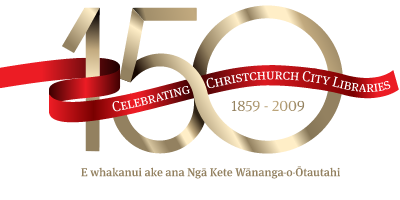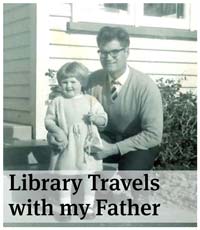A Library for Children
Public library services to children did not feature in the early days of public library development in Christchurch but once Ernest Bell, the first professional librarian was employed, advocacy and innovation in childrens’ library services began and has continued to this day as an important part the library.
Early years: Ernest J. Bell and the first Children’s Library 1914-1936
 With their own book collection established in 1914 and weekly storytelling 11 years later, the children of Christchurch had a strong advocate in their city library service.
With their own book collection established in 1914 and weekly storytelling 11 years later, the children of Christchurch had a strong advocate in their city library service.
The Children’s Library that opened in 1914 was free of charge to all children aged eight to sixteen years, but lack of room initially ruled out services such as storytelling.
On June 20, 1925, 6 months after the extensions had been completed, Miss Elliot delivered a storytelling session featuring a rendition of the Pied Piper, and the Sing Song of Old Man Kangaroo to an audience of more than 100 children. Miss Elliot’s premiere storytelling performance was well received, with a newspaper of the time reporting she had a “quiet pleasing manner”.
Delivery of a regular Storyhour had been delayed by the infantile paralysis (polio) epidemic that had swept through Canterbury. To avoid the further spread of polio, all public gatherings of children including school, church and cinema-going were banned, and the Canterbury Public Library suspended the issuing books from the Children’s Library from January 29 until April 27, 1925.
The major challenge during this period was simply filling the shelves in the new Children’s Library. A lack of funding for new book stocks meant the Library had a hard time meeting the reading demands of the children of Christchurch.
In May 1925, Ernest J. Bell launched an appeal through letters to the editors of all the local newspapers for book donations or money for the Children’s Library. Bell’s appeal touched a chord, and within a year 1600 new books had been added to the Children’s Library collection.
Funding issues and heavy demands on a limited book collection continued to dog the Children’s Library but the free service was able to be maintained without resorting to the subscription fees that applied to adult members.
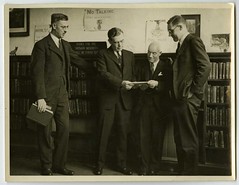 Bell continued promoting children’s library services and the development of reading skills in children in a number of initiatives. He began a twice-weekly children’s radio session in the 1920s, as well as regular talks and book reviews on the new local radio station, 3YA. He appointed a literary advisor, Miss R. Ray to help children select their reading material and by 1930 the Children’s Reading Club was well established, meeting every second Saturday morning to share favourite books and discuss new reads.
Bell continued promoting children’s library services and the development of reading skills in children in a number of initiatives. He began a twice-weekly children’s radio session in the 1920s, as well as regular talks and book reviews on the new local radio station, 3YA. He appointed a literary advisor, Miss R. Ray to help children select their reading material and by 1930 the Children’s Reading Club was well established, meeting every second Saturday morning to share favourite books and discuss new reads.
In 1928 the Children’s Library began to actively encourage schools to send classes to the library to be “instructed in the proper use of books”. School libraries at the time were practically non-existent, and children were dependent on the services and collections provided by the Canterbury Public Library. Bell commented, “We believe in getting the children to come to the library, and get themselves into the literary habit”.
An indication of the type of books provided for children can be seen in the 1936 new book collection. This included J. M. Barrie’s Peter Pan and Wendy, school stories for girls and colonial adventures or stories about heroes from British history for boys. The development of reading material for younger children had not begun at this stage as it was not considered suitable or important for children younger than eight. That was to change quite dramatically in the following decades leading to the further expansion of children’s resources and services from the 1940 and 50’s.
Opening the Doors: O'Reilly and a new approach to children's librarianship 1951-1960
With the appointment of Ronald O'Reilly as City Librarian in 1951, a new period of modernisation and expansion began. In June 1952 Dorothy K. Bowsher was appointed as the first Children's Librarian at Canterbury Public Library. Ms Bowsher had been assistant editor of Junior Bookshelf, a well-regarded English journal devoted to children's books and also had experience working in American libraries. A series of changes followed her appointment, all designed to encourage greater use of the library by children.
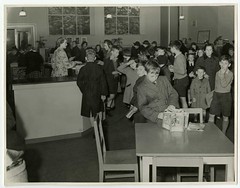 Within a year of Ms Bowhsher's appointment, as a Christmas concession, two books were allowed out per child for holiday reading. The Children's Library also introduced extended hours for the holiday period and presented a special Christmas Storyhour.
Within a year of Ms Bowhsher's appointment, as a Christmas concession, two books were allowed out per child for holiday reading. The Children's Library also introduced extended hours for the holiday period and presented a special Christmas Storyhour.
From July 1954 children were allowed to keep their own membership cards at home between library visits. The practice of requiring children to wait while their books were discharged before being given their library cards had put a strain on staff resources. Older children were now allowed to borrow two books at a time, but younger children were still restricted to one due to limited stock.
In an attempt to accommodate more children at the Children's Book Week in August 1954 children of four years and under were encouraged to bring a cushion to sit on the floor and entry to the daily Storyhour sessions was free.
During this period the popularity (or notoriety) of the library as a place for young people had grown. In a letter to the editor of the Star-Sun in September 1955 a frustrated borrower complained of the behaviour of secondary school girls and boys meeting in the library and blocking access to the shelves:
"Our excellent library seems to be coming a "happy hunting ground" for teen-age persons. Cannot someone stop all this?"
Some year later in 1960 further controversy erupted in the pages of The Press over the exclusion of popular children's books such as the works of Enid Blyton and the William series by Richmal Crompton. Despite being accused of treating "certain popular authors … with particular venom" the library stood firm on the issue, suggesting that these titles could be obtained easily by the children who wanted to read them and that the library's role was to provide quality literature for the improvement of the young minds. One correspondent disagreed, arguing that the library's role should be to provide the books that the children actually wanted to read. That correspondent would be reassured by the range of children's books available for borrowing today.
Sixties and beyond: Storytelling spaces and New Zealand stories
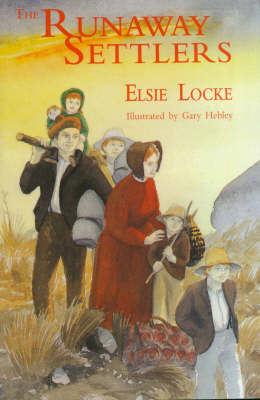 Christchurch City Libraries’ dynamic Children’s Library service grew from strength to strength with the appointment of Anne Just as Children’s Librarian in May 1963.
Christchurch City Libraries’ dynamic Children’s Library service grew from strength to strength with the appointment of Anne Just as Children’s Librarian in May 1963.
The library’s popular holiday activities and displays regularly featured in the local newspapers. Halloween storytelling began, as well as the construction of a nine foot model moa in the Children’s Library, lovingly made by Lewis Jackson the Maintenance Officer for the library at the time.
A sea-change was taking place in the selection of the Children’s Library book stock as well. Increasingly books set in New Zealand and written by New Zealanders were being published and made available in the library. Titles such as Falter Tom and The Water Boy, by Maurice Duggan (1958), and books by Phyll Wardell and Joyce West. Elsie Locke’s The Runaway Settlers was published in 1965, setting a standard for New Zealand publishing that has lasted to today, establishing a tradition of adventurous historical novels.
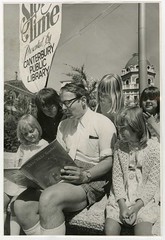 In July 1975 Bill Elderton was appointed Children’s Librarian – the first male appointed to the position. Despite a short time in the role, he continued to raise the profile of children’s services, featuring in a December issue of The Star as a “modern Pied Piper” reading stories in Cathedral Square.
In July 1975 Bill Elderton was appointed Children’s Librarian – the first male appointed to the position. Despite a short time in the role, he continued to raise the profile of children’s services, featuring in a December issue of The Star as a “modern Pied Piper” reading stories in Cathedral Square.
By that time the issue of space for children’s services had again reached crisis point. Amid much public discussion about the need for a new library building, a suggestion was made that the Children’s Library be relocated to one of the prefabs being placed at the rear of the old library building. Children’s Library staff resisted the move and were supported by the City Librarian, John Stringleman, who was concerned that this move would result in a duplication of stock and increase staffing unnecessarily.
In December 1976 Margaret Mahy, who was fast building an international reputation as a children’s writer, took on the role of Children’s Librarian. Children’s Library services were now supported by a small team, delivering a full programme of holiday craft activities and Storytimes.
By 1978 a popular new section for teenagers, Books for the Disco Set, had its own following.
The Eighties: Growing the Children’s Library Network
In 1980 Margaret Mahy, Children’s Librarian, resigned to pursue her flourishing career as children’s author full time. Cathy Thompson took over and guided the team through the tumultuous move to the new Central Library on Gloucester Street in January, 1982.
The spacious new Children’s Library accommodation, with its purpose-built storytelling pit, meant that a larger collection could be housed and more services provided such as regular school visits by the local primary schools.
Over the previous ten years new suburban branch libraries of the Canterbury Public Library had been opened in Spreydon, Papanui and Shirley, and children’s collections had also been established in those libraries.
1984 saw the first puppet show in the library – Goldilocks in Maori – a collaboration with members of the University of Canterbury Maori Club. The Labour Department had funded the employment of the puppeteers through their Project Employment Programme (PEP) operating at the time.
The demand for high quality children’s library services had grown among families living outside the Christchurch City Council’s rate-paying boundaries. In 1987 Christchurch City Council extended free borrowing to these children, allowing them access to the same service as Christchurch residents.
Other initiatives followed such as the collaboration between Cathy Thompson and Llyween Couper from The Children’s Bookshop to provide a course on children’s literature at the Christchurch Polytechnic. Each Christmas, the Children’s Library hosted an evening of booktalking to share the excitement of new titles with teachers, librarians and other interested members of the public.
Amalgamation and growth: Bill and Books for Babies
In February 1988 Bill Nagelkerke took over as Children’s Librarian.
One of the first things he did was to compile a directory of New Zealand publishers called Writing and Illustrating for Children to assist those wanting to get their work published. This publication was initially sold in the Library for 10 cents. Twenty years later it is still regulary updated and sold.
As the children’s library network expanded with the 1989 amalgamation of Christchurch’s local bodies, Bill Nagelkerke’s responsibilities expanded accordingly, and Louise Easter took over the leadership of the Children’s Library, now just one of many delivery points for children’s services.
A new and popular service to primary schools in Christchurch, the Travelling Roadshow, was launched in 1988. This was a new style of storytelling that involved children by providing costumes for them to use to act out characters and plots. The Travelling Roadshow took the library into the community, promoted Canterbury Public Library and instilled the love of story among school children.
 On April 23 1990 the Books for Babies service was launched, delivering a board book to every new-born baby in the city and promoting the importance of early childhood exposure to story. The scheme, still functioning today with the support of the Friends of the Library, was recognised in July 1998 with the presentation of the Nadia Beardsley Literacy Award.
On April 23 1990 the Books for Babies service was launched, delivering a board book to every new-born baby in the city and promoting the importance of early childhood exposure to story. The scheme, still functioning today with the support of the Friends of the Library, was recognised in July 1998 with the presentation of the Nadia Beardsley Literacy Award.
Following on from the Books for Babies success the Kids Who Read Succeed project was launched in 1995. This project involved a survey of residents in the Linwood area, where the new Linwood Library had just opened. The survey aimed to find out the level of local awareness about the library and the services it offered.
As a result of the survey feedback, a new service offering Storytimes and literacy advice for parents and caregivers was trialled for a year for preschools and kindergartens in the East Christchurch area. Due to the success of the project funds were subsequently provided to establish the programme as a permanent part of the Library service. Today the Preschool Outreach Programme has one library staff member dedicated to promoting literacy and library services to pre-schools, kindergartens and individual families.
Most recently the libraries have introduced Ready for Reading. This is a two year trial where all four year olds can come into any Christchurch City Library and pick up a Ready for Reading pack. The pack contains a purpose written book ‘Right on Time’, a jigsaw, a birthday card, and a pamphlet with tips on how parents can help their child get ready for reading.
The book, ‘Right on Time’, was written by local author Bill Nagelkerke, and librarians Louise Easter and Annette Williams, and beautifully illustrated by local artist Jenny Cooper.
